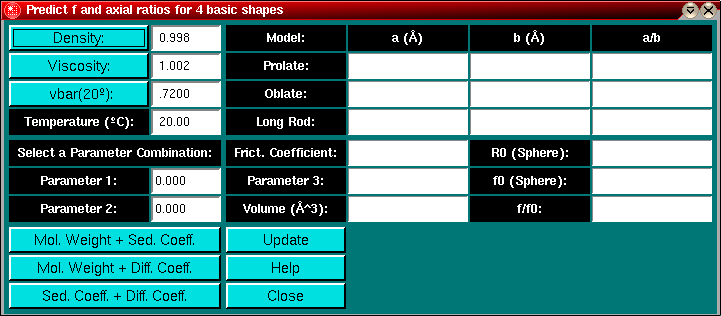

|
Manual |

You can start this model from the Simulation Menu entry in the Main Menu. Given a combination of two experimentally determined parameters (sedimentation coefficient, diffusion coefficient, or molecular weight), this module will allow you to predict the third parameter and model the molecular dimensions of a sphere, prolate ellipsoid, oblate ellipsoid and a long rod based on input parameters. Depending on the experiments performed, you may have one of the following parameter combinations available:
To use this module, select any single combination of parameters by clicking on the respective button, and then enter the parameters under the field for parameters 1 and 2. Next, click on the Update button to calculate the molecular dimensions for a sphere, an oblate and prolate ellipsoid, as well as for a long rod. Also calculated are the frictional coefficient and the frictional ratio, f/f0, which is a measure of how much a sample deviates from the frictional properties of a perfect sphere.
Keep in mind that the solutions to these models are purely theoretical and degenerate, there is no information in these parameters that would allow a definite determination of which model is most appropriate. The only model that can be excluded is a sphere, if the f/f0 ratio is larger than 1.
If the parameters have not been corrected for buffer and temperature (all results provided by UltraScan from experimental data will be corrected for buffer and temperature effect, if the buffer has been entered and applied), use the Density and Viscosity buttons to find the appropriate values from the buffer tables or enter the desired values directly into the respective text fields. Use the Vbar (20oC) button to estimate the partial specific volume from a protein sequence, or enter the partial specific volume, corrected for 20oC, directly into the corresponding text field.
Always click on the Update button to assure that the changed values have been incorporated in the calculation of the models. If you enter a selection of values that would give rise to an f/f0 value less than unity, a warning message is displayed. In such a case you should re-evalute the validity of the experimental results obtained. Please see the section on Finite Element Results Interpretation for more information on this subject.
This document is part of the UltraScan Software Documentation
distribution.
Copyright © notice.
The latest version of this document can always be found at:
Last modified on January 12, 2003.